Huawei Ascend Mate 2 Review: Incredible Battery Life & Value
by Anand Lal Shimpi & Joshua Ho on June 12, 2014 9:00 AM EST- Posted in
- Smartphones
- Huawei
- Mobile
- Ascend Mate 2
Battery Life
With each successive generation, the general trend in smartphones has been better battery life. At the high end, this is now partially gated by process node, as we see major leaps in battery life mostly coming from newer generations of SoCs running on 28LP, 28HPm, and 20nm SoC in the near future. Of course, the other direction to scale has always been battery size. This is usually most easily accomplished by simply increasing the overall device size because the total PCB area is generally constant. After all, once you have all the necessary chips that make up a smartphone, you don’t suddenly need more of them to enable a bigger version of a smartphone. Therefore, the battery can be a bigger proportion of the phone overall.
This means that the Ascend Mate2’s large size enables it to use a 3900 mAh battery, with a 14.82 WHr capacity. While I’ve used multiple phablets of similar size, none of them truly approach the level of battery capacity that the Mate2 does. Huawei even offers an accessory that allows for the Mate2 to charge other phones by drawing on the internal battery and converting it into a 5V power supply. This seems to be a feature of the TI BQ2419X charge controller on board.
At any rate, to evaluate battery life on smartphones and tablets, we run a specific workload of web pages looping endlessly until the device dies, with the display calibrated to 200 nits, with background services disabled in order to create a controlled environment.

In the WiFi test, Huawei sets a new record for battery life here, almost to a ridiculous extent. The Mate2 does around 73% better than the One (M8) in this test. A combination of the relatively low pixel density display, large battery, and low power SoC (Snapdragon 400, MSM8928) can explain how Huawei pulled this off.
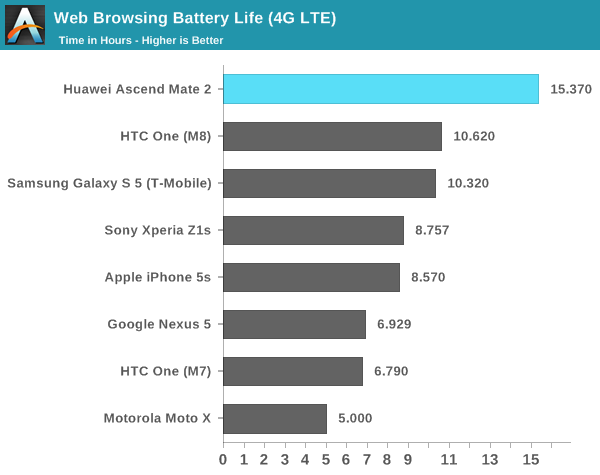
In the LTE test, while the result isn’t quite as game-breaking as in the WiFi test, Huawei still sets a new record. It’s around 48% higher than the result posted by the One (M8), and I suspect that part of the difference is due to the 28LP process that the integrated modem is built upon for the Snapdragon 400 (MSM8928), which would cause a noticeable increase in power consumption when compared to the modem in the Snapdragon 801, which is the same in design but built on a 28HPm process.
While battery life testing used to end at web browsing, we’ve now implemented more tests to see how devices perform under CPU/GPU stress tests run in endless loops. This is also run at 200 nits and controlled to ensure similar conditions from device to device. First, we’ll look at GFXBench, which does an endless loop of T-Rex until the battery dies.
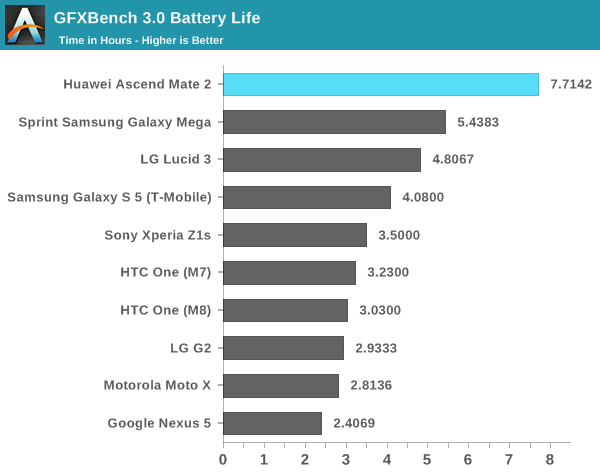
Once again, we see the same pattern. A combination of the device’s massive battery, and the relatively low power consumption of the Snapdragon 400 platform makes this phablet set new records in our battery life test.
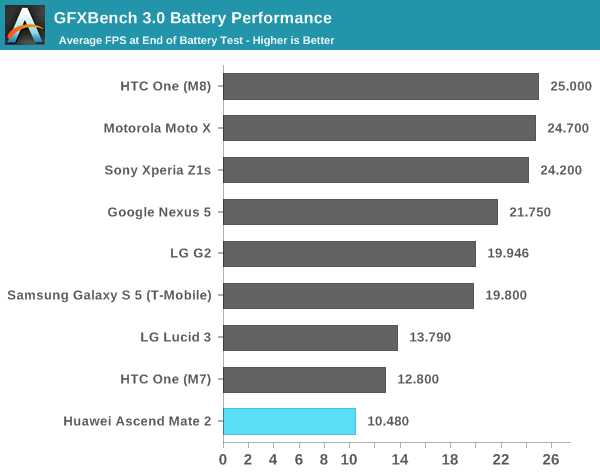
In the end of run FPS, it appears that the Mate2 effectively doesn’t throttle over time for GPU, although performance in general is a bit lower as a product of the older operating system. A more powerful GPU would produce better FPS throughout the run, although thermal throttling is more likely and battery life will be worse during the test.
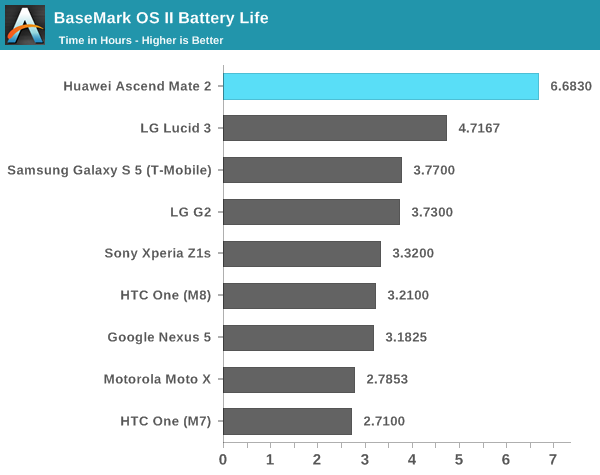
The next test is Basemark OS II on an endless loop. It’s almost a broken record now, but the Ascend Mate2 breaks our record for this test as well.
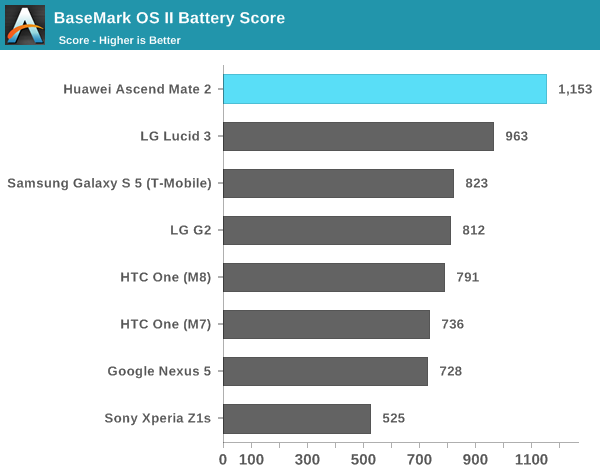
The sheer size of the device means that throttling is much less significant when looking at the final score recorded. This basically means that in most conditions, the Mate2 maintains performance without throttling. However, this is mostly a function of the low power SoC, and the trade-off is worse performance under initial conditions where all SoCs are usually not affected by thermal throttling.
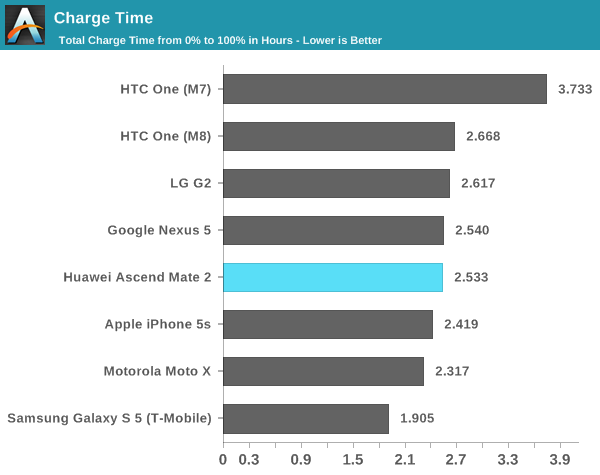
Surprisingly, the sheer size of the battery didn't affect the charge time. The Mate2 charges around as quickly as a Nexus 5. This is mostly because the Mate2 can afford to spend more time drawing the maximum possible current, which compensates for the larger battery size.
In short, there’s not much else to say here. For those that want the very best in battery life, the Ascend Mate2 is as good as it gets, based upon all of the phones that we’ve tested.










49 Comments
View All Comments
tim851 - Friday, June 13, 2014 - link
"The first place to start is industrial and material design. While many people like to suggest that any weight given to ID or MD is effectively evaluating fashion for the sake of evaluating fashion, design is critical to a phone's utility. A phone or a tablet is something that people will be constantly feeling and looking at, thus a phone that's unergonomic or finished poorly will dramatically affect the rest of the experience."I agree. The problem is that most reviews don't really criticize material or industrial design, but aesthetic design and whether or not a device is made from plastics or metal. As if metal has any advantage over metal besides it's perceived quality.
The abundant disses of Samsung's devices on the use of glossy plastics (or lately the faux materials) are totally unnecessary. Any customer can judge a phone's looks by themselves, they don't need a reviewer to help them out.
Euphonious - Saturday, June 14, 2014 - link
This review honestly tells me practically nothing about how pleasant or enjoyable the device actually is to use. You've discussed the luminance and white balance of the display in exhaustive detail whilst glossing over the software and the actual experience of using the device in three fairly short paragraphs.How much difference does it make to the real-world desirability of a phone if its saturation accuracy is 3.6063 rather than 3.8685? Nobody is going to notice that, but they will notice a shoddy UI or an unergonomic design. Reducing everything to numbers really misses the pleasure and pain points which make a good or a bad phone.
nrfitchett4 - Friday, March 20, 2015 - link
I bought this about 3 months ago and don't regret it at all. Sold my LG G2 to amazon for 145 and got this for 290. It is a little unwieldy at times due to size, but its easy to use, runs really well and I haven't had any software problems. I don't use many apps these days, and only play a couple of games so 16gb of storage with a 32gb micro sd card works fine for me. I unlocked mine using code from Huawei (all you have to do is ask) and rooted it. Its running JB, but I'm scared of what lollipop would do to an already great software experience. I wasn't a fan of the UI at first, but decided against 3rd party launchers when I saw how much battery they were eating.torimish - Sunday, June 15, 2014 - link
I really think Huawei deserves some more brand recognition. I'm in Australia, and I recently purchased the Huawei Mediapad Honor X1 - basically a 7" phablet, a great convergence device. I've done away with my ultrabook, and use this while travelling with a BT keyboard, and while it's pretty big for pocket use, it's easy to stash in my hand-bag.The quality of these phones - and the price point they are currently sitting at - make for excellent value. I took a gamble (was advised build quality wasn't up to some of the other devices), but I have been very pleasantly surprised. This Ascend looks good, too.
I'd seriously recommend anyone try these Huawei devices. Build quality and finish is up there with the likes of Samsung and Sony and Apple. I'd really like to see Anand do a review of the Mediapad X1. You can't argue with fully unlocked, broad gamut of 4G/LTE bands, 1920x1200 resolution etc for less than $400 USD . . . and all day or two battery life.
MarkWebb - Tuesday, June 17, 2014 - link
Ordered!mikkej2k - Thursday, July 10, 2014 - link
OK phone.Gethuawei.com website is broken. Call in customer service is also awful - be careful.
zlinghaha - Wednesday, August 6, 2014 - link
Avoid this crap. I just got the phone but found it cannot connect to a mobile network when I turn off Wi-Fi after it stays on Wi-Fi for some time. It cannot connect to a mobile network even after I re-start the device. This is over-hyped crap.FarWestNow - Tuesday, December 23, 2014 - link
A good phone with a great camera (13mp). It's big, but I got used to it pretty quickly. I drop phones constantly, so I bought a Trident case, which so far seems to be fine. (looked for an Otter Box but they don't make one for the AM2.) Only real downside is that it gobbles up data like a fiend and my model came stuffed w/Google apps, and I've had to shut off the mobile network data manually when I'm off Wi-Fi to make sure I stay under my data cap. Four out of five stars....nrfitchett4 - Friday, March 20, 2015 - link
turn off auto-sync. I haven't noticed any extra data used. You can turn off mobile data as well, leaving only wifi, phone and sms on.